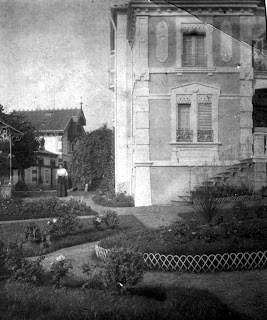
Here is a mystery for you. I think I have the answer, but I don't want to give it away. The door at the front entrance has the initials C & J over the doorway. What do the letters stand for?
L'histoire de Graffigny-Chemin et ma famille Chevallier. The history of Graffingy-Chemin and my family Chevallier.

 |
| La maison de Graffigny de ma grandmere |
 |
| Graffigny-Chemin |

"[Art,] I added a file here on some documents that I had received from a distant cousin in California awhile back on the White Family. This would be Daddy Mat's G-grandmother's line Mary White b1790- d 1883."George included a link to a pdf file so that all of the correspondence and documentation on the Whites would be available. Thanks George.



"My grandmother's house is still there, but it isn't the same. ...
I drive by the strangers,
And wish that they could see what I see. ...
I still the ghosts of the people I knew long ago. ...
Secret gardens of the heart,
Where the old stay young forever. ...
But, most of all, it is me that has changed. .."






"Turn off Hwy 280 onto Slaughter’s Crossing Road. Go .9 mi - turn left,
over RR track, take right at 1.6 ½ miles, R at 2.4
(walk to top of hill, cemetery is on the left.)
N32 degrees 49.788 minutes W 085 degrees 41.344 minutes"
Gen. C. L. Pearson April 10, 1854 Jan. 12, 1940
One or two broken
James Madison Pearson 17th Oct 1817 Died 11th Nov. 1891 Age 74 yrs. 25 days.
Son of Wm. H. & Mary W. Pearson born Jasper Co, Ga.
Edward W. Pearson Nov. 21, 1860 July 31, 1862 Son of James W. and
Elizabeth A. Pearson
Mrs. Elizabeth A. Pearson Wife of James M. Pearson and Daughter of
James N. & Martha Brown
My grandfather James Madison Pearson was born in 1884 in Dadeville,
Tallapoosa County, Alabama. His father Dr.Benjamin Rush Pearson, was
born 1849, also in Dadeville,Tallapoosa, County, Alabama.Dr. Pearson
received his diploma to practice medicine in 1881 from the Medical
College of Alabama in Mobile.Thereafter, he practiced in the city of Montgomery.


 My grandfather James Madison Pearson is the officer seated center front row. To his right and left are a captain and lieutenant. Staff Sergeants flank the two officers.
My grandfather James Madison Pearson is the officer seated center front row. To his right and left are a captain and lieutenant. Staff Sergeants flank the two officers. These are views of Graffigny-Chemin from afar.
These are views of Graffigny-Chemin from afar. The first privately made postcard, where postage had to be affixed, was introduced in Austria in 1869 and by 1870, picture postcards were all the rage!
The first privately made postcard, where postage had to be affixed, was introduced in Austria in 1869 and by 1870, picture postcards were all the rage!






 Those servicemen who saw active duty in campaigns had the campaigns listed on the ribbon.
Those servicemen who saw active duty in campaigns had the campaigns listed on the ribbon.